Mapping Scientific Knowledge of Renewable Energy and Tourism
Abstract
1. Introduction
2. Data and Methods
3. Results
3.1. Evolution of Publications on Renewable Energy and Tourism
3.2. Document Type and Citation
3.3. Distribution of the Literature and Subject Area
3.4. Countries and Journals
Citations by Country
3.5. Journals and Quartile
3.6. Most Cited Documents
3.7. Most Influential Authors
3.8. Keyword Co-Occurrence Network
4. Discussion
5. Conclusions
- (a)
- The publication of articles is the preferred method of authors because it represents a greater reach in the scientific community and a higher number of citations per TC/TP paper.
- (b)
- From 2016 to 2023, the number of publications has grown exponentially due to the importance of renewable energy and tourism in countries seeking to achieve sustainable tourism.
- (c)
- China is the most productive country in terms of scientific publications.
- (d)
- The most relevant journals are “Environmental Science and Pollution Research”, “Environment Development and Sustainability”, and “Renewable Energy”.
- (e)
- A keyword and citation analysis of the study documents reveals future directions, beginning with “environmental economics”, “sustainable tourism”, and “carbon emissions”.
- (a)
- Identifies the role of renewable energy in tourism through bibliometric elements that allow us to verify how the field of study has changed over time.
- (b)
- Demonstrates how a search criterion visualizes the relationship between different economic sectors and fields of knowledge.
- (c)
- The document facilitates discourse among students, academics, and decision-makers regarding trends in renewable energy applied to tourism.
- (d)
- The Gompertz equation proposed to measure the rate of publication over time is a significant contribution to the field. It allows for the comparison of the potential and trend of countries in terms of publications. The speed at which publications are produced can be used to know if there is growth and to identify the direction of future trends.
Limitations
Author Contributions
Funding
Institutional Review Board Statement
Informed Consent Statement
Data Availability Statement
Conflicts of Interest
References
- Olcina, C.J. Turismo y cambio climático: Una actividad vulnerable que debe adaptarse. Investig. Turísticas 2012, 4, 1. [Google Scholar] [CrossRef][Green Version]
- Pulido-Fernández, J.I.; López-Sánchez, Y. Turismo y cambio climático. Propuesta de un marzo estratégico de acción. Rev. Econ. Mund. 2014, 36, 257–283. [Google Scholar]
- Espinoza, R. Huella ecológica y turismo sustentable. Teoría Prax. 2006, 2, 147–156. [Google Scholar]
- Gómez Martín, M.B. Retos del turismo español ante el cambio climático. Investig. Geográficas 2017, 67, 31. [Google Scholar] [CrossRef][Green Version]
- Guerrero-Moreno, M.A.; Oliveira-Junior, J.M.B. Approaches, Trends, and Gaps in Community-Based Ecotourism Research: A Bibliometric Analysis of Publications between 2002 and 2022. Sustainability 2024, 16, 2639. [Google Scholar] [CrossRef]
- Alamineh, G.A.; Hussein, J.W.; Mulu, Y.E.; Taddesse, B. The Negative Cultural Impact of Tourism And its Implication on Sustainable Development in Amhara Regional State. Cogent Arts Humanit. 2023, 10, 2224597. [Google Scholar] [CrossRef]
- Rutty, M.; Scott, D. Bioclimatic comfort and the thermal perceptions and preferences of beach tourists. Int. J. Biometeorol. 2014, 59, 37–45. [Google Scholar] [CrossRef]
- WTO, World Tourism Organization. Climate Change and Tourism—Responding to Global Challenges; UNWTO: Madrid, Spain, 2008. [Google Scholar]
- Tutti, A.C. Cambio Climático y Turismo. Master’s Thesis, Universidad Nacional de Mar del Plata, Mar del Plata, Argentina, 2011. [Google Scholar]
- Gössling, S.; Hall, C.M.; Peeters, P.; Scott, D. The Future of Tourism: Can Tourism Growth and Climate Policy be Reconciled? A Mitigation Perspective. Tour. Recreat. Res. 2010, 35, 119–130. [Google Scholar] [CrossRef]
- Ásványi, K.; Juhász-Dóra, K.; Jászberényi, M.; Michalkó, G. Literature Review of Renewable Energy in the Tourism Industry. J. Adv. Res. Manag. 2017, 8, 476–491. [Google Scholar]
- Huseynli, B. The Role of Renewable Energy in the Development of the Tourism Sector. Afr. J. Hosp. Tour. Leis. 2022, 11, 1924–1936. [Google Scholar]
- Cheung, M.; Fan, J. Carbon reduction in a high-density city: A case study of Langham Place Hotel Mongkok Hong Kong. Renew. Energy 2013, 50, 433–440. [Google Scholar] [CrossRef]
- Kuldasheva, Z.; Ahmad, M.; Salahodjaev, R.; Fahlevi, M. Do Tourism and Renewable Energy Influence CO2 Emissions in Tourism-Dependent Countries? Int. J. Energy Econ. Policy 2023, 13, 146–152. [Google Scholar] [CrossRef]
- Karabuga, A.; Yakut, M.Z.; Yakut, G.; Selbas, R.; Üçgül, I. Renewable energy solutions for tourism. Eur. Sci. J. Behav. Sci. 2015, 153, 501–509. [Google Scholar]
- Li, J.; Cao, B. Resources policies for solar development and eco-tourism expansion in emerging economies. Resour. Policy 2024, 88, 104460. [Google Scholar] [CrossRef]
- Ghimire, B.T.; Muneenam, U.; Techato, K. Renewable Energy Use in Green Hotels for Sustainability: A Systematic Review. Int. J. Energy Econ. Policy 2023, 13, 618–627. [Google Scholar] [CrossRef]
- Álvarez-García, J.; Durán-Sánchez, A.; del Río-Rama, M.d.C.; Simonetti, B. Big data and tourism research: Measuring research impact. Qual. Quant. 2023, 57 (Suppl. 3), 271–292. [Google Scholar] [CrossRef]
- Halepoto, H.; Gong, T.; Noor, S.; Memon, H. Bibliometric Analysis of Artificial Intelligence in Textiles. Materials 2022, 15, 2910. [Google Scholar] [CrossRef] [PubMed]
- Halepoto, H.; Gong, T.; Memon, H. A Bibliometric Analysis of Antibacterial Textiles. Sustainability 2022, 14, 11424. [Google Scholar] [CrossRef]
- Flores-Romero, M.B.; Pérez-Romero, M.E.; Álvarez-García, J.; del Río-Rama, M.d.l.C. Bibliometric Mapping of Research on Magic Towns of Mexico. Land 2021, 10, 852. [Google Scholar] [CrossRef]
- Pang, Y.; Marinello, F.; Tang, P.; Li, H.; Liang, Q. Bibliometric Analysis of Trends in Smart Irrigation for Smart Agriculture. Sustainability 2023, 15, 16420. [Google Scholar] [CrossRef]
- Jiménez-Islas, D.; Pérez-Romero, M.E.; García, J.Á.; Del Río-Rama, M.D.L.C. A Model Study of Growth of Publications on the Field of Biofuels. Int. J. Des. Nat. Ecodyn. 2023, 18, 51–62. [Google Scholar] [CrossRef]
- Cheng, T.-Y.; Yu-Chieh Ho, S.; Chien, T.-W.; Chou, W. Global research trends in artificial intelligence for critical care with a focus on chord network charts: Bibliometric analysis. Medicine 2023, 102, e35082. [Google Scholar] [CrossRef] [PubMed]
- UNFCCC. Decision 1/CP.21: Adoption of the Paris Agreement, UNFCCC Secretariat, Bonn. 2015. Available online: https://unfccc.int/resource/docs/2015/cop21/eng/10a01.pdf (accessed on 11 May 2020).
- Aksnes, D.W.; Langfeldt, L.; Wouters, P. Citations, Citation Indicators, and Research Quality: An Overview of Basic Concepts and Theories. SAGE Open 2019, 9, 215824401982957. [Google Scholar] [CrossRef]
- Aksnes, D.W.; Piro, F.N.; Fossum, L.W. Citation metrics covary with researchers’ assessments of the quality of their works. Quant. Sci. Stud. 2023, 4, 105–126. [Google Scholar] [CrossRef]
- Lee, Y.-S.; Chow, J.C.; Chien, T.-W.; Chou, W. Using chord diagrams to explore article themes in 100 top-cited articles citing Hirsch’s h-index since 2005: A bibliometric analysis. Medicine 2023, 102, e33057. [Google Scholar] [CrossRef] [PubMed]
- Campanario, J. Journals that Rise from the Fourth Quartile to the First Quartile in Six Years or Less: Mechanisms of Change and the Role of Journal Self-Citations. Publications 2018, 6, 47. [Google Scholar] [CrossRef]
- Asan, A.; Aslan, A. Quartile Scores of Scientific Journals: Meaning, Importance and Usage. Acta Medica Alanya 2020, 4, 102–108. [Google Scholar] [CrossRef]
- Wang, J.; Wu, J.; Zhang, J.; Guan, L.; Feng, H.; Zhu, K.; Zhang, Y.; Zhao, W.; Peng, Q.; Meng, B.; et al. Bibliometric and visualized analysis of hydrogels in organoids research. Regen. Ther. 2024, 25, 395–404. [Google Scholar] [CrossRef]
- Ben Jebli, M.; Ben Youssef, S.; Apergis, N. The dynamic linkage between renewable energy, tourism, CO2 emissions, economic growth, foreign direct investment, and trade. Lat. Am. Econ. Rev. 2019, 28, 2. [Google Scholar] [CrossRef]
- Isik, C.; Dogru, T.; Turk, E.S. A nexus of linear and non-linear relationships between tourism demand, renewable energy consumption, and economic growth: Theory and evidence. Int. J. Tour. Res. 2017, 20, 38–49. [Google Scholar] [CrossRef]
- Khan, M.T.I.; Yaseen, M.R.; Ali, Q. Nexus between financial development, tourism, renewable energy, and greenhouse gas emission in high-income countries: A continent-wise analysis. Energy Econ. 2019, 83, 293–310. [Google Scholar] [CrossRef]
- Alola, A.A.; Alola, U.V. Agricultural land usage and tourism impact on renewable energy consumption among Coastline Mediterranean Countries. Energy Environ. 2018, 29, 1438–1454. [Google Scholar] [CrossRef]
- Zhang, S.; Liu, X. The roles of international tourism and renewable energy in environment: New evidence from Asian countries. Renew. Energy 2019, 139, 385–394. [Google Scholar] [CrossRef]
- Shah, S.A.R.; Balsalobre-Lorente, D.; Radulescu, M.; Zhang, Q.; Hussain, B. Revising the tourism-induced environment Kuznets curve hypothesis in top 8 Asian economies: The role of ICT and renewable energy consumption. J. Hosp. Tour. Technol. ahead-of-print. 2022. [Google Scholar]
- Balsalobre-Lorente, D.; Leitão, N.C. The role of tourism, trade, renewable energy use and carbon dioxide emissions on economic growth: Evidence of tourism-led growth hypothesis in EU-28. Environ. Sci. Pollut. Res. 2020, 27, 45883–45896. [Google Scholar] [CrossRef] [PubMed]
- Leitão, N.C.; Balsalobre-Lorente, D. The Effects of Tourism, Economic Growth and Renewable Energy on Carbon Dioxide Emissions. In Strategies in Sustainable Tourism, Economic Growth and Clean Energy; Springer: Cham, Switzerland, 2020; pp. 67–87. [Google Scholar]
- Balsalobre-Lorente, D.; Leitão, N.C.; Driha, O.M.; Cantos-Cantos, J.M. The Impact of Tourism and Renewable Energy Use Over Economic Growth in Top 10 Tourism Destinations. In Strategies in Sustainable Tourism, Economic Growth and Clean Energy; Springer: Cham, Switzerland, 2020; pp. 1–14. [Google Scholar]
- Leitão, N.C.; Lorente, D.B. The Linkage between Economic Growth, Renewable Energy, Tourism, CO2 Emissions, and International Trade: The Evidence for the European Union. Energies 2020, 13, 4838. [Google Scholar] [CrossRef]
- Ali, Q.; Yaseen, M.R.; Anwar, S.; Makhdum, M.S.A.; Khan, M.T.I. The impact of tourism, renewable energy, and economic growth on ecological footprint and natural resources: A panel data analysis. Resour. Policy 2021, 74, 102365. [Google Scholar] [CrossRef]
- Ali, Q.; Khan, M.T.I.; Khan, M.N.I. Dynamics between financial development, tourism, sanitation, renewable energy, trade and total reserves in 19 Asia cooperation dialogue members. J. Clean. Prod. 2018, 179, 114–131. [Google Scholar] [CrossRef]
- Riojas-Díaz, K.; Jaramillo-Romero, R.; Calderón-Vargas, F.; Asmat-Campos, D. Sustainable Tourism and Renewable Energy’s Potential: A Local Development Proposal for the La Florida Community, Huaral, Peru. Economies 2022, 10, 47. [Google Scholar] [CrossRef]
- Calderón-Vargas, F.; Asmat-Campos, D.; Chávez-Arroyo, P. Sustainable tourism policies in Peru and their link with renewable energy: Analysis in the main museums of the Moche route. Heliyon 2021, 7, e08188. [Google Scholar] [CrossRef]
- Calderón-Vargas, F.; Asmat-Campos, D.; Carretero-Gómez, A. Sustainable Tourism and Renewable Energy: Binomial for Local Development in Cocachimba, Amazonas, Peru. Sustainability 2019, 11, 4891. [Google Scholar] [CrossRef]
- Dogru, T.; Bulut, U.; Kocak, E.; Isik, C.; Suess, C.; Sirakaya-Turk, E. The nexus between tourism, economic growth, renewable energy consumption, and carbon dioxide emissions: Contemporary evidence from OECD countries. Environ. Sci. Pollut. Res. 2020, 27, 40930–40948. [Google Scholar] [CrossRef] [PubMed]
- Isik, C.; Radulescu, M. Investigation of the relationship between renewable energy, Tourism receipts and economic growth in Europe. Czech Stat. Off. 2017, 27, 85–94. [Google Scholar]
- Ismail, A.; Rashid, A.S.A.; Amhadi, T.; Nazir, R.; Irsyam, M.; Faizal, L. Exploring the Evolution of Seismic Hazard and Risk Assessment Research: A Bibliometric Analysis. Sustainability 2024, 16, 2687. [Google Scholar] [CrossRef]
- Gao, F.; Jia, X.; Zhao, Z.; Chen, C.; Xu, F.; Geng, Z.; Song, X. Bibliometric Analysis on Tendency and Topics of Artificial Intelligence over Last Decade. Microsyst. Technol. 2019, 27, 1545–1557. [Google Scholar] [CrossRef]
- Setiawan, M.I.; Sukoco, A.; Abdullah, D.; Erliana, C.I.; Halim, P.; Badruddin, S.; Budiyanto, H. G20, Infrastructure Tourism, and Renewable Energy Tourism. IJEBD (Int. J. Entrep. Bus. Dev.) 2023, 6, 371–380. [Google Scholar] [CrossRef]
- Thi, D.; Tran, V.Q.; Nguyen, D.T. The relationship between renewable energy consumption, international tourism, trade openness, innovation and carbon dioxide emissions: International evidence. Int. J. Sustain. Energy 2023, 42, 397–416. [Google Scholar] [CrossRef]
- Kampire, E.; Mudaheranwa, E.; Byiringiro, R.; Barorukize, J.B.; Habimana, J.C.; Ntakirutimana, D. The Possibility of Renewable Energy based Tourism in Rwanda: A proposal for Karongi Community in Western Province. In Proceedings of the 2022 IEEE PES/IAS PowerAfrica, Kigali, Rwanda, 22–26 August 2022; pp. 1–5. [Google Scholar]
- Becken, S.; Hay, J. Climate Change and Tourism: From Policy to Practice; Routledge: London, UK, 2012. [Google Scholar]
- Higham, J.E.; Cohen, S.A.; Cavaliere, C.T. Climate change, discretionary air travel, and the “Flyers’ Dilemma”. J. Travel Res. 2014, 53, 462–475. [Google Scholar] [CrossRef]
- Gössling, S.; Peeters, P. Assessing tourism’s global environmental impact 1900–2050. J. Sustain. Tour. 2015, 23, 639–659. [Google Scholar] [CrossRef]
- Scott, D.; Gössling, S.; Hall, C.M.; Peeters, P. Can tourism be part of the decarbonized global economy? The costs and risks of alternate carbon reduction policy pathways. J. Sustain. Tour. 2016, 24, 52–72. [Google Scholar] [CrossRef]
- Mechili, M.; Vaitsis, C.; Argirusis, N.; Pandis, P.K.; Sourkouni, G.; Argirusis, C. Research progress in transition metal oxide based bifunctional electrocatalysts for aqueous electrically rechargeable zinc-air batteries. Renew. Sustain. Energy Rev. 2022, 156, 111970. [Google Scholar] [CrossRef]
- Kammen, D.M.; Kapadia, K.; Fripp, M. Putting Renewables to Work: How Many Jobs Can the Clean Energy Industry Generate? RAEL Report; DIANE Publishing: Collingdale, PA, USA, 2004. [Google Scholar]
- Ewing, R.; Rong, F. The impact of urban form on US residential energy use. Hous. Policy Debate 2008, 19, 1–30. [Google Scholar] [CrossRef]
- Blanco, M.I.; Rodrigues, G. Direct employment in the wind energy sector: An EU study. Energy Policy 2009, 37, 2847–2857. [Google Scholar] [CrossRef]
- Wei, M.; Patadia, S.; Kammen, D.M. Putting renewables and energy efficiency to work: How many jobs can the clean energy industry generate in the US? Energy Policy 2010, 38, 919–931. [Google Scholar] [CrossRef]
- Gössling, S.; Scott, D.; Hall, C.M. Pandemics, tourism and global change: A rapid assessment of COVID-19. J. Sustain. Tour. 2020, 29, 1–20. [Google Scholar] [CrossRef]
- International Energy Agency (IEA). World Energy Investment 2023. IEA. 2023. Available online: https://www.iea.org/reports/world-energy-investment-2023 (accessed on 22 January 2024).
- BloombergNEF. Energy Transition Investment Trends 2024. BloombergNEF. 2024. Available online: https://about.bnef.com (accessed on 22 January 2024).
- Deloitte. 2024 Renewable Energy Industry Outlook. Deloitte Insights, 2024. Available online: https://www2.deloitte.com (accessed on 22 January 2024).
- Ekka, B.; Das, G.; Aarif, M.; Alalmai, A. Unveiling the significance of sustainability in tourism: Environmental conservation, Socioeconomic development, and destination resilience. Riv. Ital. Di Filos. Anal. Jr. 2023, 14, 918–933. [Google Scholar]
- Sharpley, R.; Telfer, D.J. Transformations in tourism and development. In Rethinking Tourism and Development; Edward Elgar Publishing: Cheltenham, UK, 2023; pp. 12–42. [Google Scholar]
- International Renewable Energy Agency (IRENA). Transition to Renewables Calls for New Approach to Energy Security. 2024. Available online: https://www.irena.org (accessed on 22 January 2024).
- Dredge, D.; Jamal, T. Progress in tourism planning and policy: A post-structural perspective on knowledge production. Tour. Manag. 2015, 51, 285–297. [Google Scholar] [CrossRef]
- Wei, S.; Jiandong, W.; Saleem, H. The impact of renewable energy transition, green growth, green trade and green innovation on environmental quality: Evidence from top 10 green future countries. Front. Environ. Sci. 2023, 10, 1076859. [Google Scholar] [CrossRef]
- Mirziyoyeva, Z.; Salahodjaev, R. Renewable energy, GDP and CO2 emissions in high-globalized countries. Front. Energy Res. 2023, 11, 1123269. [Google Scholar] [CrossRef]
- Wang, D.; Li, J.; Liu, Y. Evaluating barriers and strategies to green energy innovations for sustainable development: Developing resilient energy systems. Front. Energy Res. 2023, 11, 1201692. [Google Scholar] [CrossRef]
- Moscardo, G. Sustainable tourism innovation: Challenging basic assumptions. Tour. Hosp. Res. 2008, 8, 4–13. [Google Scholar] [CrossRef]
- Dangi, T.B.; Jamal, T. An integrated approach to “sustainable community-based tourism”. Sustainability 2016, 8, 475. [Google Scholar] [CrossRef]
- Becken, S.; Simmons, D.G. Understanding energy consumption patterns of tourist attractions and activities in New Zealand. Tour. Manag. 2002, 23, 343–354. [Google Scholar] [CrossRef]
- Lane, B. Thirty years of sustainable tourism: Drivers, progress, problems—And the future. In Sustainable Tourism Futures; Routledge: London, UK, 2009; pp. 19–32. [Google Scholar]
- Scott, D.; Hall, C.M.; Stefan, G. Tourism and Climate Change: Impacts, Adaptation and Mitigation; Routledge: London, UK, 2012. [Google Scholar]
- Gössling, S. National emissions from tourism: An overlooked policy challenge? Energy Policy 2013, 59, 433–442. [Google Scholar] [CrossRef]
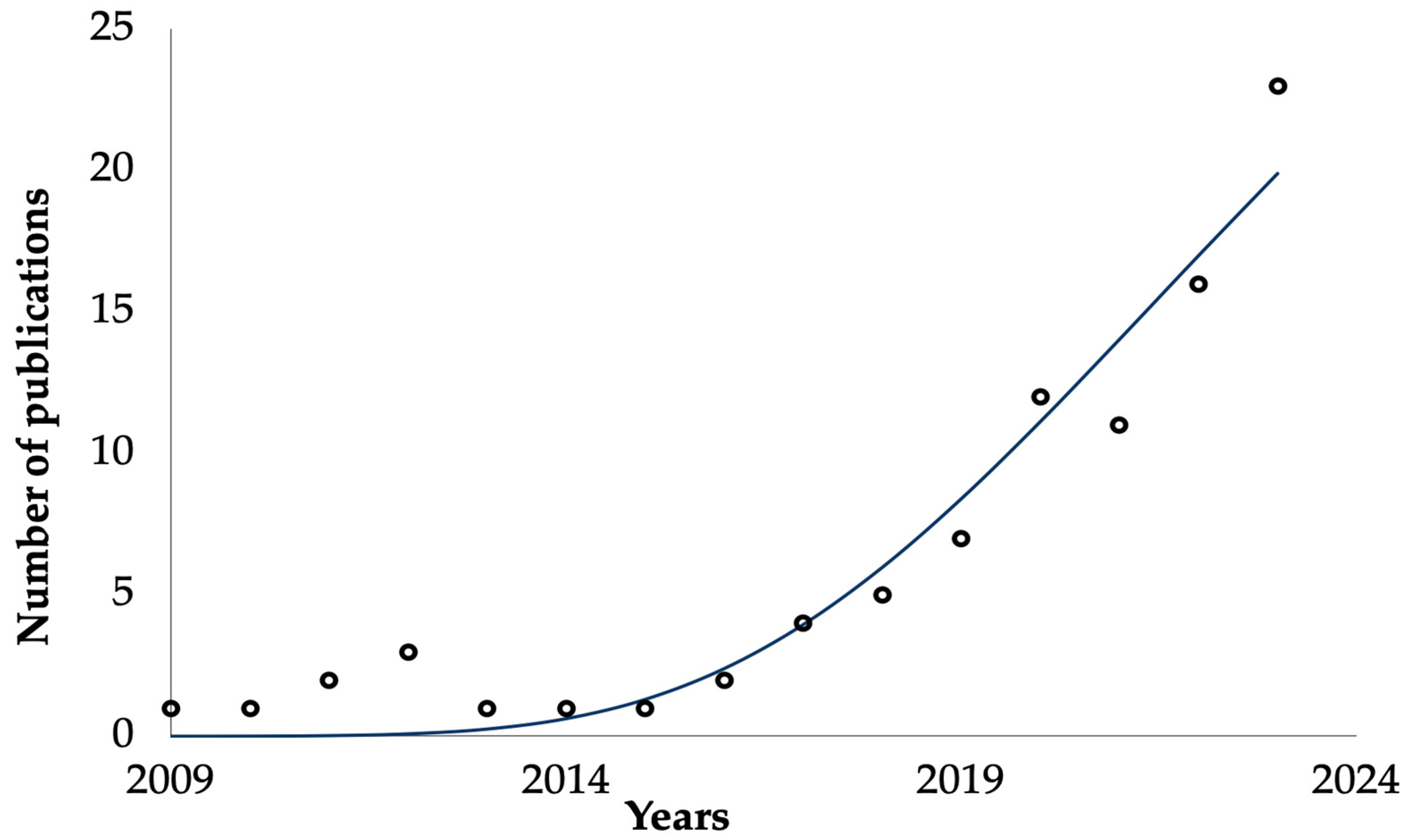
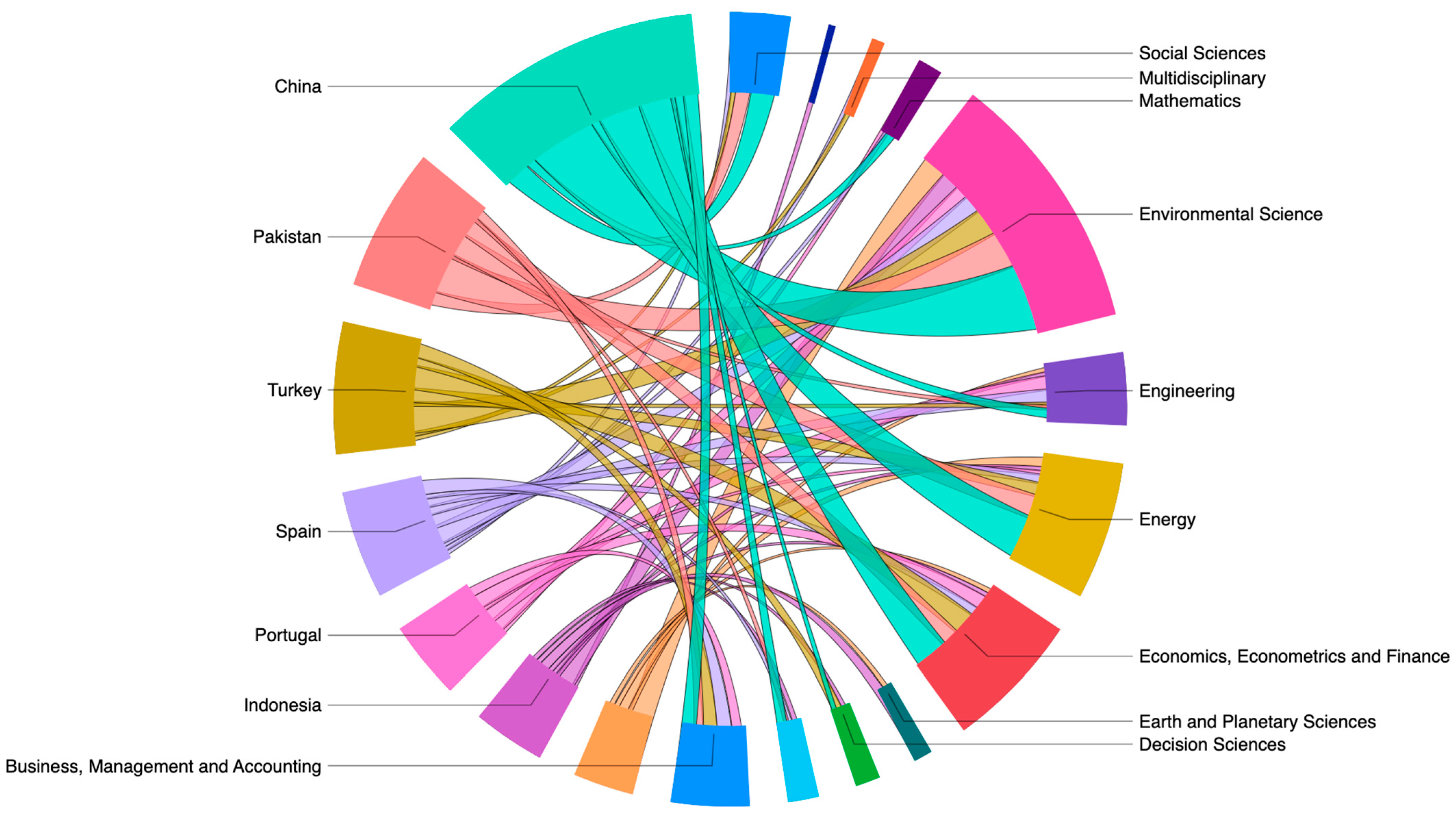
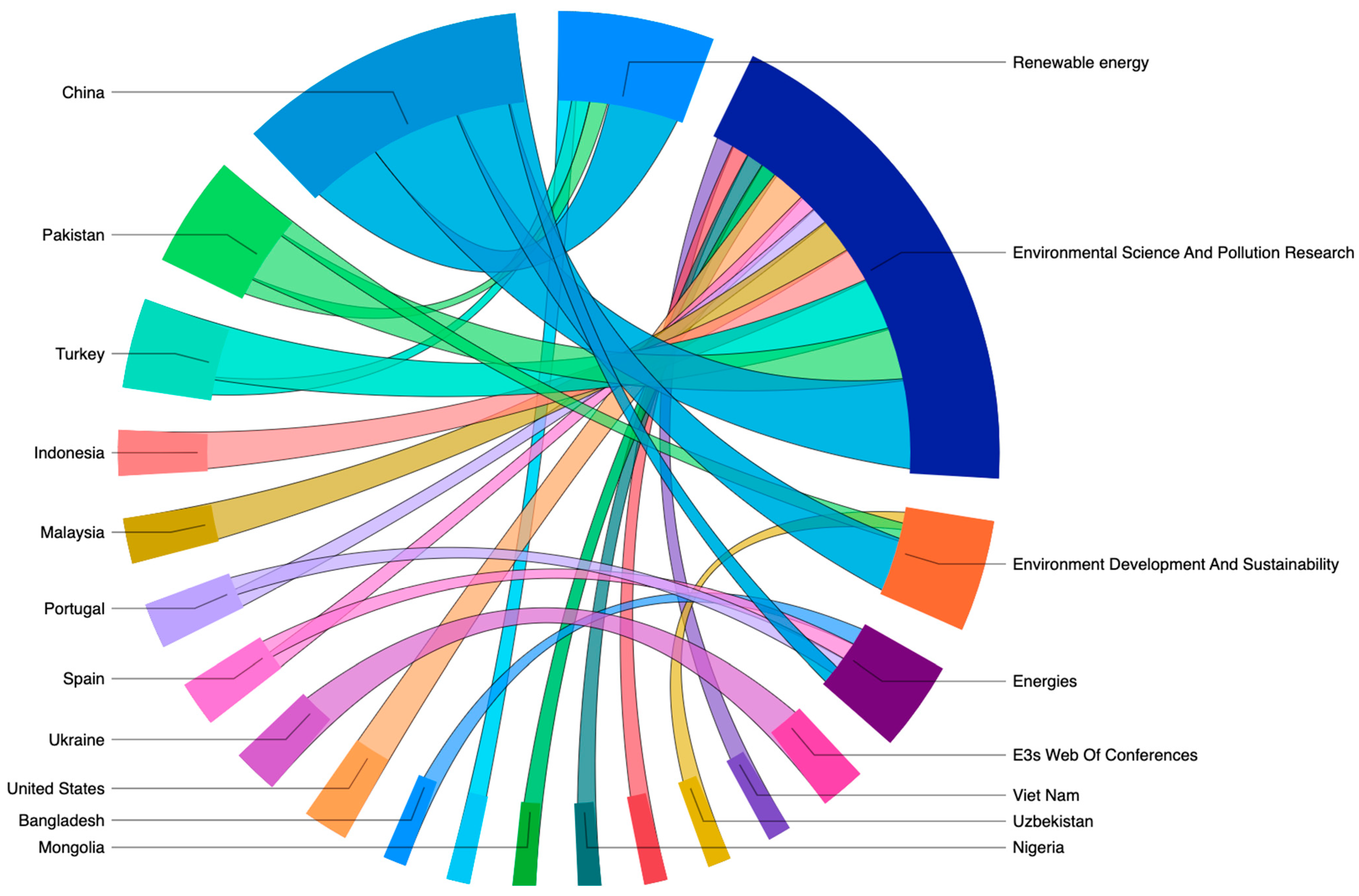
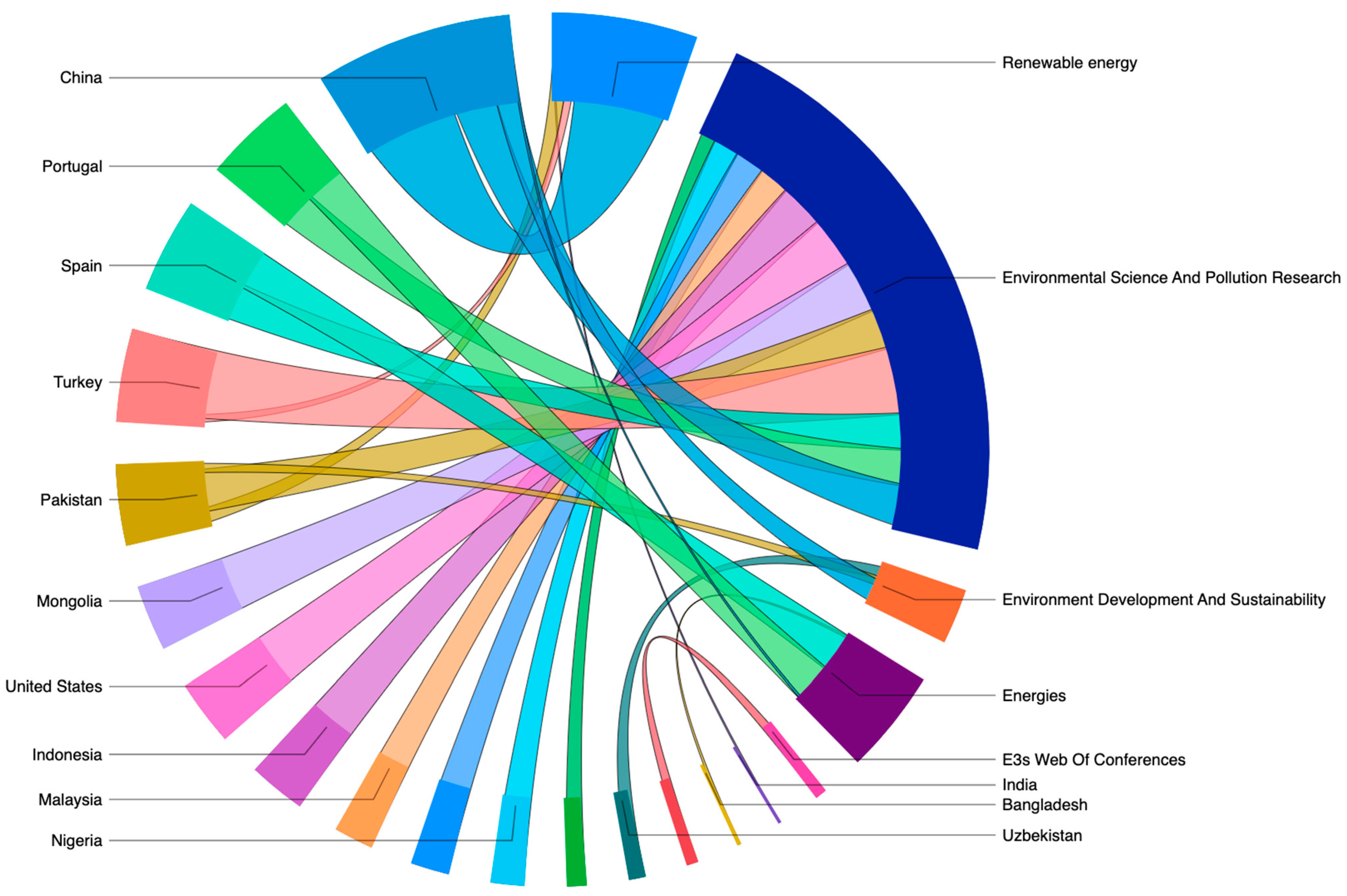
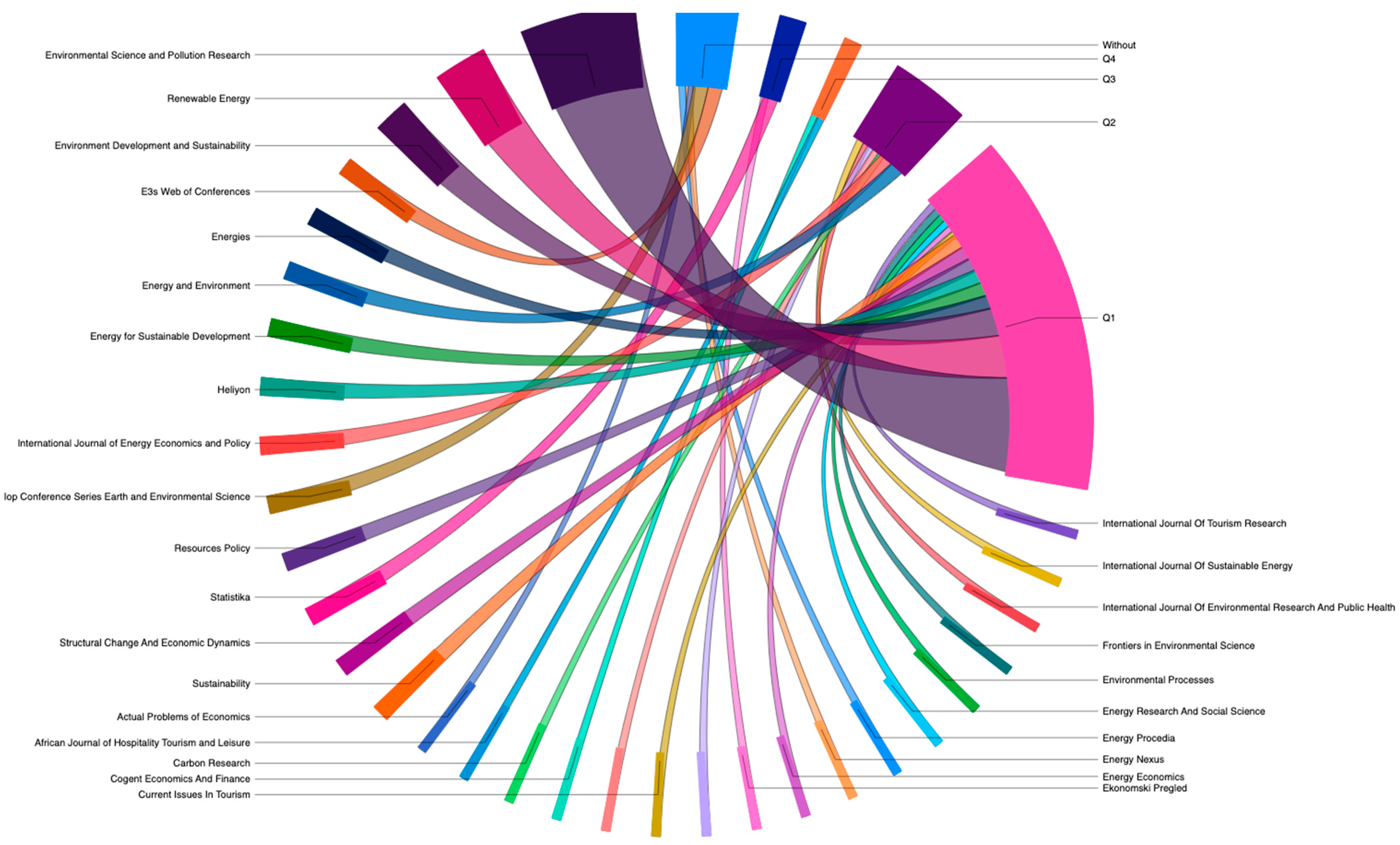
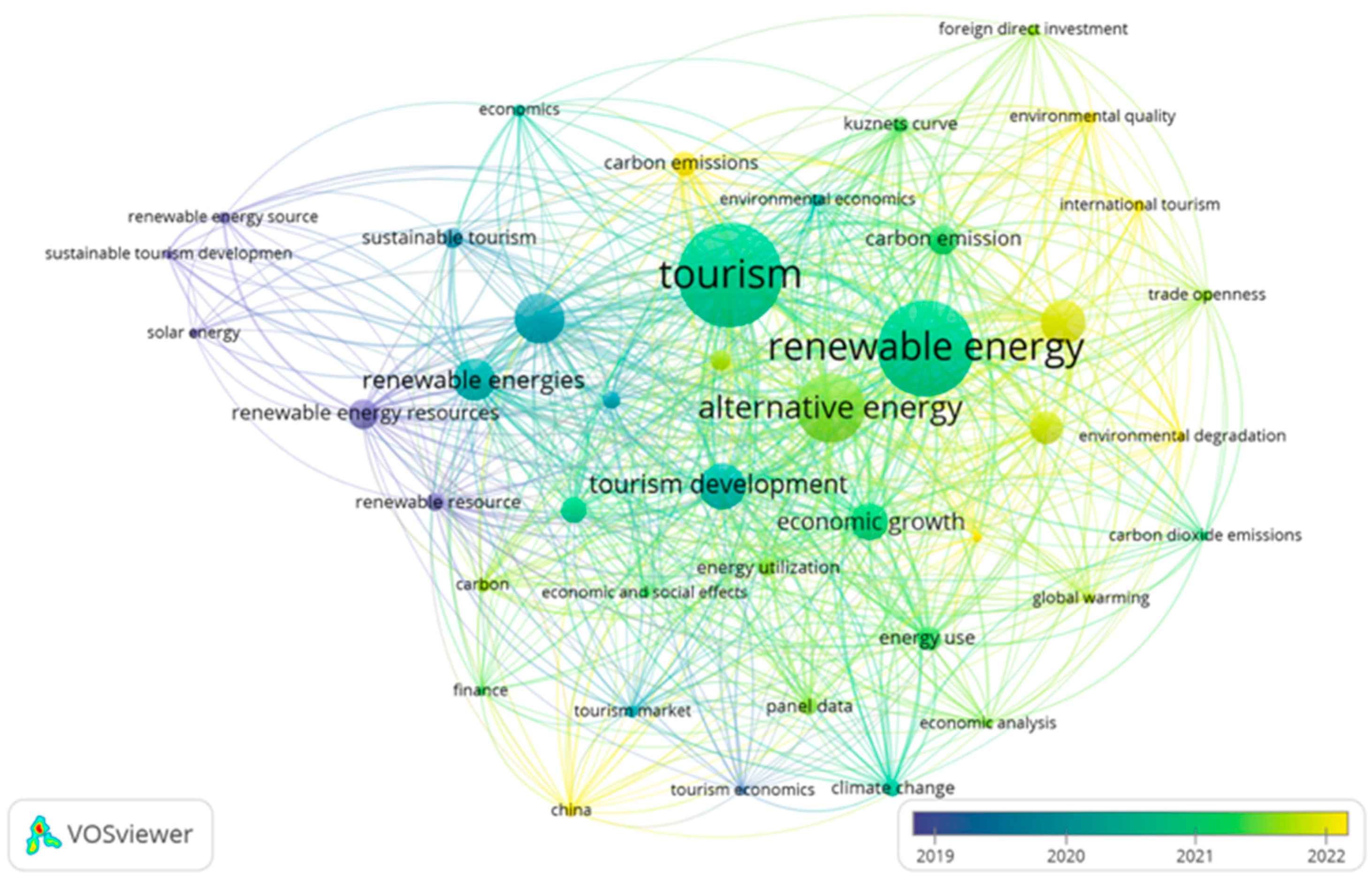
| Rank | Document Type | TP | Ratio (%) | TC (2008–2023) | Ratio (%) | TC/TP |
|---|---|---|---|---|---|---|
| 1 | Article | 69 | 77 | 2298 | 96.4 | 33.4 |
| 2 | Conference paper | 12 | 13 | 64 | 2.7 | 5.3 |
| 3 | Book chapter | 5 | 6 | 8 | 0.3 | 1.6 |
| 4 | Review | 4 | 4 | 14 | 0.6 | 3.5 |
| TC | Title | Journal | Main Objectives | Authors |
|---|---|---|---|---|
| 204 | The dynamic linkage between renewable energy, tourism, emissions, economic growth, foreign direct investment, and trade | Latin American Economic Review | Assesses the relevance of the link between tourism and renewable energy, exploring the causal relationships between renewable energy consumption and economic growth for a panel of 22 Central and South American countries, covering the period 1995–2010. | [32] |
| 169 | A nexus of linear and non-linear relationships between tourism demand, renewable energy consumption, and economic growth: Theory and evidence | International Journal of Tourism Research | The objective of the paper was to evaluate the relationships between tourism development, clean energy consumption, and economic growth in countries such as the USA, France, Spain, China, Italy, Turkey, and Germany using the bootstrap panel Granger causality model. | [33] |
| 147 | Nexus between financial development, tourism, renewable energy, and greenhouse gas emission in high-income countries: A continent-wise analysis | Energy Economics | In 34 high-income nations across three continents (Asia, Europe, and America), this study examined the relationship between GHG emissions and tourism, the financial development index, energy usage, renewable energy, and commerce from 1995 to 2017. | [34] |
| 131 | Agricultural land usage and tourism impact on renewable energy consumption among Coastline Mediterranean Countries | Energy and Environment | This empirical study, which covers the years 1995–2014 in 16 coastal Mediterranean countries, attempts to look at the dynamic response of renewable energy consumption to long-run disequilibrium and short-run impacts of tourism development and agricultural land usage. | [35] |
| 114 | The roles of international tourism and renewable energy in environment: New evidence from Asian countries | Renewable Energy | Analyzes the relationship between emissions from ten countries located in Northeast and Southeast Asia to determine their interaction with energy (renewable and non-renewable) and tourism in the period 1995–2014. | [36] |
| Rank | Author | TP | TC | Institutions | Period | TC/TP | Ref. |
|---|---|---|---|---|---|---|---|
| 1 | Balsalobre-Lorente Daniel | 4 | 122 | Universidad de Castilla-La Mancha, Ciudad Real, Spain | 2020–2022 | 30.5 | [37,38,39] |
| 2 | Leitão Nuno Carlos | 4 | 220 | University of Évora, Evora, Portugal | 2020 | 55 | [38] |
| 3 | Ali Qamar | 3 | 315 | Virtual University of Pakistan, Faisalabad, Pakistan | 2018–2021 | 105 | [34,42,43] |
| 4 | Asmat-Campos David | 3 | 29 | Universidad Privada del Norte, Trujillo, Peru | 2019–2022 | 9.6 | [44,45,46] |
| 5 | Calderón-Vargas Fátima | 3 | 29 | Universidad Privada del Norte, Trujillo, Peru | 2019–2022 | 9.6 | [44,45,46] |
| 6 | Işık Cem | 3 | 314 | Anadolu Üniversitesi, Eskisehir, Turkey | 2017–2020 | 104.6 | [33,47,48] |
Disclaimer/Publisher’s Note: The statements, opinions and data contained in all publications are solely those of the individual author(s) and contributor(s) and not of MDPI and/or the editor(s). MDPI and/or the editor(s) disclaim responsibility for any injury to people or property resulting from any ideas, methods, instructions or products referred to in the content. |
© 2024 by the authors. Licensee MDPI, Basel, Switzerland. This article is an open access article distributed under the terms and conditions of the Creative Commons Attribution (CC BY) license (https://creativecommons.org/licenses/by/4.0/).
Share and Cite
Jiménez-Islas, D.; Pérez-Romero, M.E.; Álvarez-García, J.; del Río-Rama, M.d.l.C. Mapping Scientific Knowledge of Renewable Energy and Tourism. Sustainability 2024, 16, 6356. https://doi.org/10.3390/su16156356
Jiménez-Islas D, Pérez-Romero ME, Álvarez-García J, del Río-Rama MdlC. Mapping Scientific Knowledge of Renewable Energy and Tourism. Sustainability. 2024; 16(15):6356. https://doi.org/10.3390/su16156356
Chicago/Turabian StyleJiménez-Islas, Donaji, Miriam E. Pérez-Romero, José Álvarez-García, and María de la Cruz del Río-Rama. 2024. "Mapping Scientific Knowledge of Renewable Energy and Tourism" Sustainability 16, no. 15: 6356. https://doi.org/10.3390/su16156356
APA StyleJiménez-Islas, D., Pérez-Romero, M. E., Álvarez-García, J., & del Río-Rama, M. d. l. C. (2024). Mapping Scientific Knowledge of Renewable Energy and Tourism. Sustainability, 16(15), 6356. https://doi.org/10.3390/su16156356








